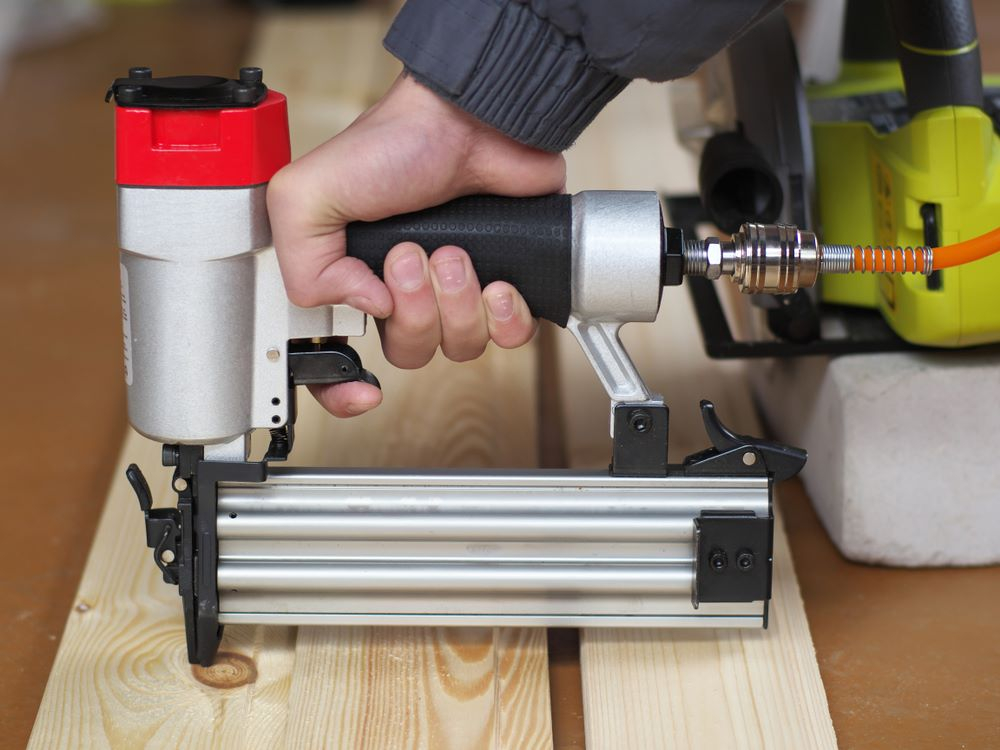Brad nailers and finish nailers are both types of pneumatic or electric tools that are used to drive nails into wood or other materials. However, there are some key differences between the two types of nailers that can help you decide which one is best for your needs.
One of the main differences between brad nailers and finish nailers is the size and strength of the nails they use. Brad nailers are designed to drive smaller, thinner nails called brads, which are typically 18-gauge in thickness. These nails are not strong enough to hold together heavier pieces of wood on their own, but they are useful for finish work such as attaching trim or molding.
Finish nailers, on the other hand, are designed to drive larger, stronger nails called finish nails, which are typically 15- or 16-gauge in thickness. These nails are strong enough to hold together larger pieces of wood and are often used for tasks such as installing baseboards or framing.
Another difference between brad nailers and finish nailers is the size and power of the tools themselves. Brad nailers are generally smaller and lighter than finish nailers, which makes them easier to handle and maneuver in tight spaces. However, finish nailers are generally more powerful and are better suited for heavy-duty tasks.
In terms of cost, brad nailers and finish nailers are generally similar, with both types of tools ranging in price from a few hundred dollars to several thousand dollars depending on the features and capabilities of the tool.
Overall, the choice between a brad nailer and a finish nailer will depend on the specific needs of your project. If you are working on a small or decorative project that requires the use of thin, lightweight nails, a brad nailer may be the better choice. However, if you are working on a larger, more structural project that requires the use of stronger nails, a finish nailer may be a better fit.
Contents
What Is Brad Nailer And How It Works
A brad nailer is a type of pneumatic tool that is used to drive small, thin nails called brads into wood or other materials. These nails are typically about 18-gauge in thickness and are used for finishing work, as they are not strong enough to hold together heavier pieces of wood on their own.
There are several different types of brad nailers available, including manual, electric, and pneumatic models. Pneumatic brad nailers are the most popular and are powered by compressed air, which is delivered through an air hose. Electric brad nailers are corded or battery-powered and are generally easier to use and maintain, but they may not be as powerful as pneumatic models. Manual brad nailers are the least common and require the user to manually squeeze the trigger to drive each nail.
The main benefit of using a brad nailer is speed and accuracy. It is much faster and easier to use a brad nailer to drive a large number of nails than it is to do so manually with a hammer. Additionally, brad nailers can place nails with greater precision than a hammer, which can be important for certain types of projects.
How to choose the right brad nailer
- When selecting a brad nailer, there are a few key factors to consider to ensure you choose the right tool for your needs.
- Size: Brad nailers come in different sizes, with some being more suitable for smaller projects and others being better suited for larger tasks. Consider the size of the projects you will be working on when choosing a brad nailer.
- Power source: As mentioned earlier, brad nailers are available in pneumatic, electric, and manual models. Pneumatic brad nailers are the most powerful and are ideal for heavy-duty projects, but they do require an air compressor and air hose. Electric brad nailers are less powerful but are easier to use and maintain, and they do not require an air compressor. Manual brad nailers are the least powerful but may be a good choice for very small projects or for those who do not have access to a power source.
- Price: Brad nailers range in price from a few hundred dollars to several thousand dollars, depending on the features and capabilities of the tool. Consider your budget and the features you need when choosing a brad nailer.
Using a brad nailer
- Safety is always a top priority when using any power tool. When using a brad nailer, be sure to wear eye protection, as the nails being driven by the tool can fly out at high speeds. It is also a good idea to wear ear protection, as brad nailers can be quite loud.
- To use a brad nailer, follow these steps:
- Connect the air hose to the nailer and the air compressor.
- Load the brads into the nailer according to the manufacturer’s instructions.
- Position the nailer against the wood or other material where you want to place the brad.
- Hold the nailer with both hands and squeeze the trigger to drive the brad into the material.
- Repeat the process as needed until the desired number of brads have been placed.
Tips & Tricks
- Some tips for getting the best results when using a brad nailer include:
- Always use the correct size and type of brads for the material you are working with.
- Hold the nailer at a slight angle to the material to ensure the brads are driven in straight.
- Use a hammer to gently tap any brads that are not fully
What Is Finish Nailer And How It Works
A finish nailer is a type of pneumatic or electric tool that is used to drive larger nails called finish nails into wood or other materials. These nails are typically 15- or 16-gauge in thickness and are used for finish work, such as installing baseboards, crown molding, and other decorative trim.
- There are several different types of finish nailers available, including manual, electric, and pneumatic models. Pneumatic finish nailers are the most powerful and are ideal for heavy-duty projects, but they do require an air compressor and air hose. Electric finish nailers are corded or battery-powered and are generally easier to use and maintain, but they may not be as powerful as pneumatic models. Manual finish nailers are the least common and require the user to manually squeeze the trigger to drive each nail.
- The main benefit of using a finish nailer is speed and accuracy. It is much faster and easier to use a finish nailer to drive a large number of nails than it is to do so manually with a hammer. Additionally, finish nailers can place nails with greater precision than a hammer, which can be important for certain types of projects.
How to choose the right finish nailer
- When selecting a finish nailer, there are a few key factors to consider to ensure you choose the right tool for your needs.
- Size: Finish nailers come in different sizes, with some being more suitable for smaller projects and others being better suited for larger tasks. Consider the size of the projects you will be working on when choosing a finish nailer.
- Power source: As mentioned earlier, finish nailers are available in pneumatic, electric, and manual models. Pneumatic finish nailers are the most powerful and are ideal for heavy-duty projects, but they do require an air compressor and air hose. Electric finish nailers are less powerful but are easier to use and maintain, and they do not require an air compressor. Manual finish nailers are the least powerful but may be a good choice for very small projects or for those who do not have access to a power source.
- Price: Finish nailers range in price from a few hundred dollars to several thousand dollars, depending on the features and capabilities of the tool. Consider your budget and the features you need when choosing a finish nailer.
Using a finish nailer
- Safety is always a top priority when using any power tool. When using a finish nailer, be sure to wear eye protection, as the nails being driven by the tool can fly out at high speeds. It is also a good idea to wear ear protection, as finish nailers can be quite loud.
- To use a finish nailer, follow these steps:
- Connect the air hose to the nailer and the air compressor (if using a pneumatic model).
- Load the finish nails into the nailer according to the manufacturer’s instructions.
- Position the nailer against the wood or other material where you want to place the nail.
- Hold the nailer with both hands and squeeze the trigger to drive the nail into the material.
- Repeat the process as needed until the desired number of nails have been placed.
Tips & Tricks
- Some tips for getting the best results when using a finish nailer include:
- Always use the correct size and type of nails for the material you are working with.
- Hold the nailer at a slight angle to the material to ensure the nails are driven in straight.
- Use a hammer to gently tap any nails that are not fully driven in.
Final Take
Brad nailers and finish nailers are both useful tools that can be used for a variety of tasks, including finish work and framing. However, there are some key differences between the two types of nailers that can help you decide which one is best for your needs. Brad nailers are designed to drive smaller, thinner nails called brads, which are typically 18-gauge in thickness and are useful for finish work such as attaching trim or molding.
Finish nailers, on the other hand, are designed to drive larger, stronger nails called finish nails, which are typically 15- or 16-gauge in thickness and are often used for tasks such as installing baseboards or framing. Ultimately, the choice between a brad nailer and a finish nailer will depend on the specific needs of your project and your personal preferences.

